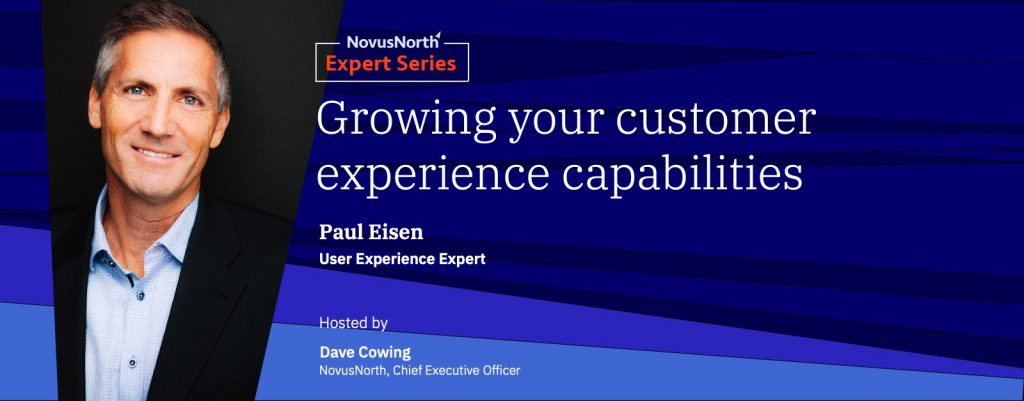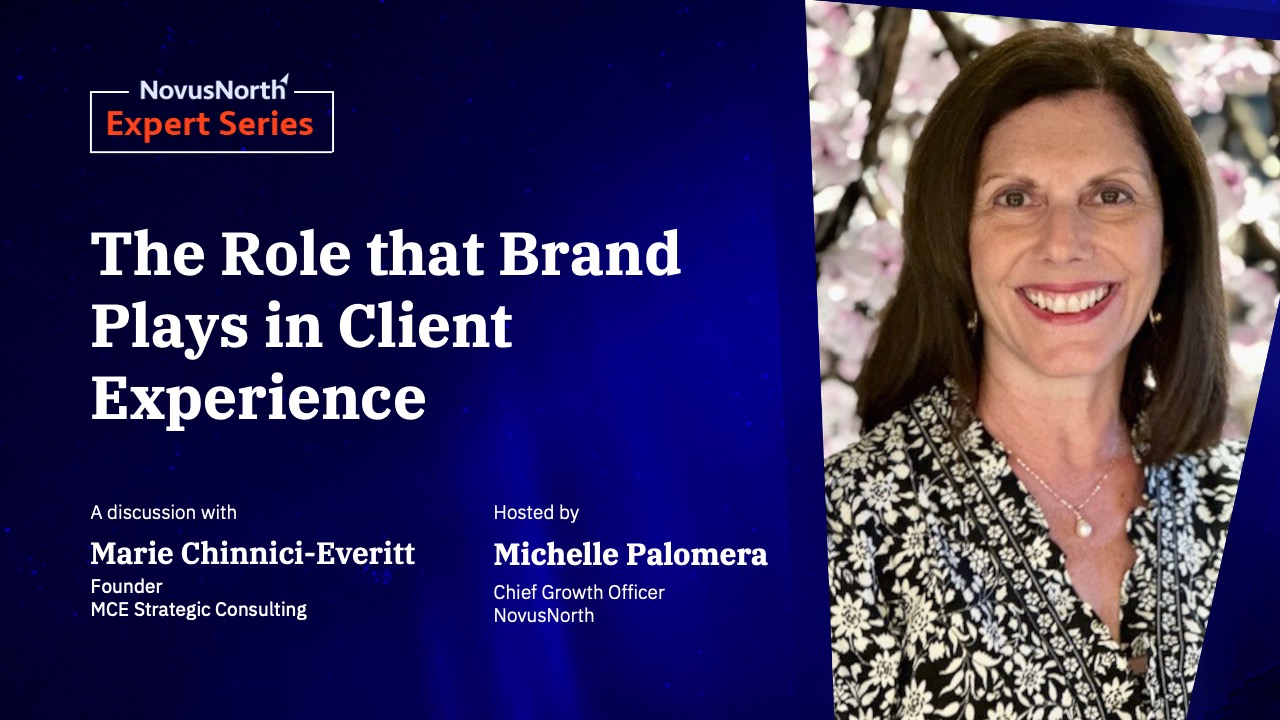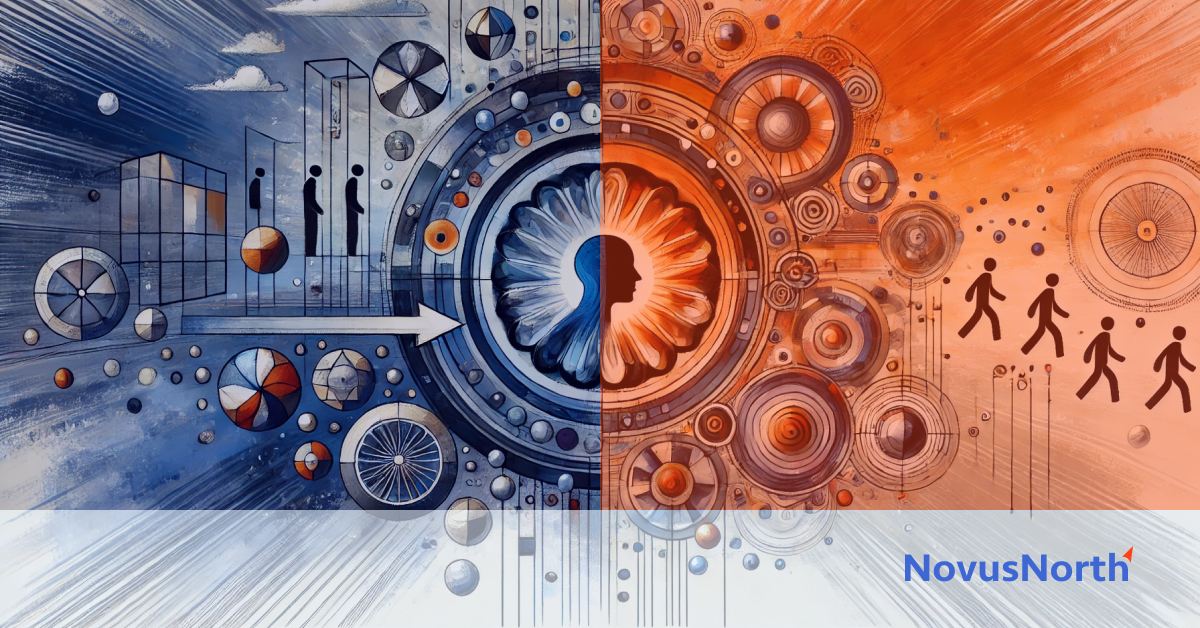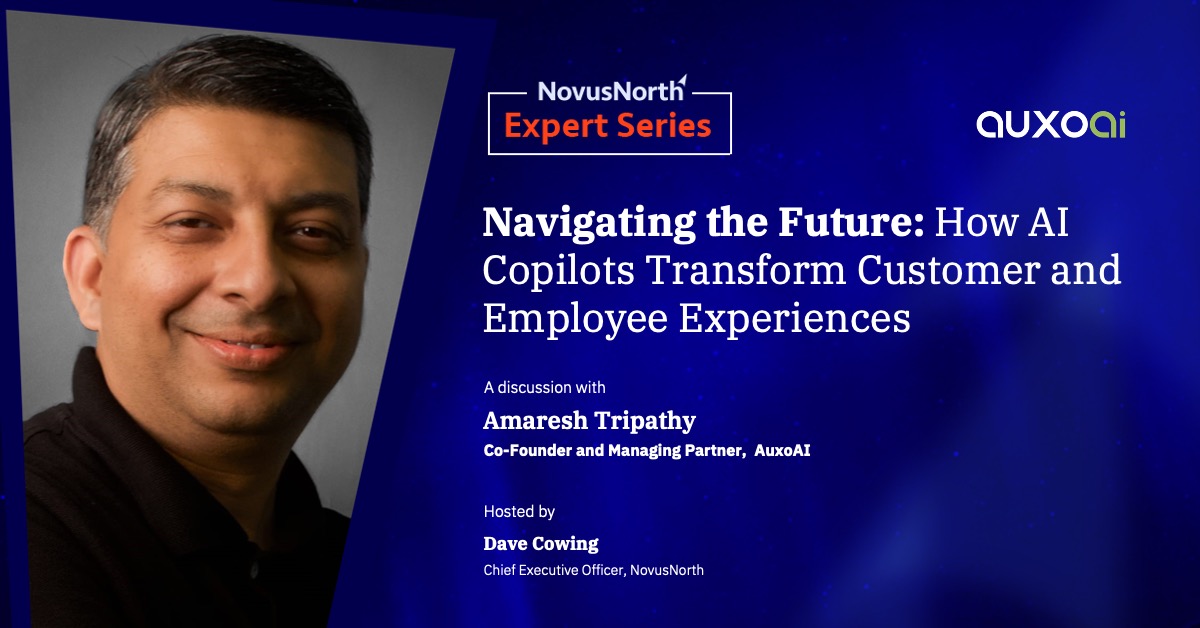In this edition of NovusNorth’s thought leadership conversation, Dave Cowing, CEO of NovusNorth, had an opportunity to meet Paul Eisen, award-winning user experience expert.
Paul Eisen has led user experience initiatives across many industries, including financial services, healthcare and consumer packaged goods. Across these varied industries he’s defined and executed human-centered strategies and research; and designed technology-enabled business solutions for customers, employees, vendors and suppliers.
An area of particular interest to Paul is experience practice development, that is, helping organizations large and small put the pieces in place to be able to create great experiences for their customers, employees, and business partners.
Paul also serves as an educator at the University of Toronto, trying to inspire a whole new generation of prospective UX specialists.
NovusNorth is an expert-lead provider of product design, development and delivery services for the FinTech and financial services industry. At NovusNorth, we believe that great digital experiences drive great outcomes.
In this article, we summarize the conversation between Dave Cowing and Paul Eisen.
Read the Transcript
Q: What do we mean by customer experience and user experience?
Paul Eisen
Customer experience is the sum total of all interactions that a customer has with a company across multiple touchpoints involving sales, service and support, while user experience typically refers to the technology components. Now, the bottom line is this. No matter how you may want to position your company’s brand image through your marketing and sales efforts, the experience that you create is your brand.
“The experience you create is your brand.”
– Paul Eisen
“The experience that you create is your brand.”
– Paul Eisen
Q: Why should companies care about creating great digital experiences?
Paul Eisen
I mentioned that the experience that you create is your brand. So, let’s connect brand to business results. This notion of “brand equity” is real. A study by Forbes has shown that for every dollar invested in improving the customer experience, businesses generate around three dollars in return and an 11% increase in revenue. And we also know that companies that invest in design and experience, leaders in the experience space, have greater increases in their valuations than laggards, those who do not invest in design and experience sufficiently. This leadership and this increased share price come through their core operating financials, things like lower cost, customer acquisition, higher customer loyalty, higher employee loyalty, lower customer churn, share of wallet. And then there’s the expense side where there are decreases in development and operating expenses.
Q: There clearly are some compelling hard dollar benefits delivering customer experience. Do you have any examples you can share with us?
Paul Eisen
Sure, that’s a great idea. Why don’t we touch on a couple of real world examples. One of them is a well-known case study where a global technology company with thousands of employees applied human-centered methods to redesign a piece of internal employee-facing software. The results were a productivity benefit of $6.8 million which represents 100 times just in the first year their direct investment in the user experience methods. Now with a large workforce, you can see how the multipliers can be staggering.
I’ll give you another example from my personal experience. A team that I was part of redesigned an ecommerce website in the consumer electronics space using human-centered methods. And we focused on the path to purchase from the homepage through to the product listing and the details pages. And importantly, we started with experience research to understand the information that customers value most in the shopping experience for this particular type of consumer electronics. We then applied best practices in design to render the experience. We restructured both the product listing and the details pages. The result was an immediate and sustained lift in sales of over 50% through the online channel.
“The result was an immediate and sustained lift in sales of over 50%”
– Paul Eisen
“The result was an immediate and sustained lift in sales of over 50%”
– Paul Eisen
Q: Super interesting Paul, a 50% lift is clearly compelling. I love hearing about how companies are achieving business results through the use of human centric methods. Given all this potential value, where should companies start?
Paul Eisen
To do this right, an organization needs to evolve to become truly human-centered. This means that when you create solutions, you need to apply the right methods to discover what end users truly value and then how to deliver that value and only that value. In fact, it’s estimated that billions of dollars are wasted every year globally, in creating features and functions that are not valued by users, and so they’re simply not used.
Now you can and you should start small. So, pick one or two particularly important and high-profile initiatives. For startups this may represent your core and your only offering. While for larger companies this may be a project or a platform that is particularly important to your business growth. Then you need to find the right people inside your company and augment the team is needed with experienced researchers and designers. Execute the methodology faithfully and showcase your results.
“billions of dollars are wasted every year globally, in creating features and functions that are not valued by users.”
– Paul Eisen
“billions of dollars are wasted every year globally, in creating features and functions that are not valued by users.”
– Paul Eisen
Q: You know, I love that idea of starting small but all together this sounds like a lot of change. I’ve got to believe there’s cultural change, operating changes, a mindset shift. How can companies go about doing this?
Paul Eisen
Well, you’ve hit the nail on the head Dave, this is about organizational change. And specifically in the domain of experience there are five capability areas or as I refer to them as pillars that you need to focus on. The first is standards. Now these are best practices in interaction and service design that you adopt for your organization. Now for interaction design there are great pattern libraries out there, such as Google’s Material Design, that you can use as a start.
Alongside this is a human-centered methodology that needs to be codified and integrated into your lifecycle methodologies. Nobody needs a new methodology, but effective integration into your existing methodologies is possible and recommended. Now this is based on the philosophy of Design Thinking and Lean UX, for example, which is a way to integrate experience practices with agile practices.
So, there are standards and methodology and then of course, you need to build the skills and capabilities within the organization in order to continue to develop these and execute against them. We’re talking about people skilled in ethnographic research, experience, strategy, and experience design.
Now across this to ensure that you’re moving in the right direction you need to install a measurement framework. This will allow you to track the successful the success of the initiatives, and of the overall program.
Now to round out this framework you have standards, methodology skills, measurement. And finally, you need to overlay this with a governance model that’s going to work effectively in your culture.
Q: It sounds like a fantastic framework to help companies think about creating capabilities. One of the things that we’ve seen is this notion of stages in developing UX maturity. If I go back to one of your earlier points, you said you recommend that folks start small. With that in mind, how should they start with your framework? And how long should they expect it to take to get to full maturity?
Paul Eisen
You need to walk before you run. In fact, just like other large cultural transformations, such as Agile, you need to evolve this at a pace that your organization can absorb. Now, to do this, you look at those five pillars we just talked about, and they each have to grow in a balanced way. So, for an organization that is highly committed, earlier stage of formation and therefore more nimble, you’re looking at about a year and a half to two years to be able to reach a target level of maturity. While larger, more established organizations, that may have a bit more organizational inertia, we’re expecting typically three to five years to be able to evolve to a full state of maturity.
Q: It sounds like a fantastic framework to help companies think about creating capabilities. One of the things that we’ve seen is this notion of stages in developing UX maturity. If I go back to one of your earlier points, you said you recommend that folks start small. With that in mind, how should they start with your framework? And how long should they expect it to take to get to full maturity?
Paul Eisen
You need to walk before you run. In fact, just like other large cultural transformations, such as Agile, you need to evolve this at a pace that your organization can absorb. Now, to do this, you look at those five pillars we just talked about, and they each have to grow in a balanced way. So, for an organization that is highly committed, earlier stage of formation and therefore more nimble, you’re looking at about a year and a half to two years to be able to reach a target level of maturity. While larger, more established organizations, that may have a bit more organizational inertia, we’re expecting typically three to five years to be able to evolve to a full state of maturity.
Q: Terrific this super insightful. I love the framework. I love the notion of starting small and evolving but I guess there’s a lot of complexities in implementing such a program. What do you see as the top two to three risks to look out for?
Paul Eisen
I’m glad you asked this question about risks, because there are a whole bunch of gotchas. I’ll just mention a few. The first is thinking that you can test your way to a good experience. I used to work with a large financial services organization that executed pretty faithfully, rigorously on the traditional software development lifecycle: requirements, design, development, and user acceptance testing. And towards the end of that cycle, they would reach out to the experience team and say “we understand we need to run this through usability,” which could conjure up this image of a carwash and out would the solution come squeaky clean and full of great experiences at the other end. So just like any mature quality-oriented methodology, you can’t build in quality or experience as an afterthought.
“you can’t build in quality or experience as an afterthought.”
– Paul Eisen
“you can’t build in quality or experience as an afterthought.”
– Paul Eisen
Related to this is another flaw that you often see which is skipping discovery research. So the solution approach and the capabilities you want to build need to be grounded in the human insights that you’ve got gathered from discovery research. If you skip this step you risk creating a superficially good user interface for a product or solution that really doesn’t provide value to the end user.
The last thing I’ll mention is something a bit more technical to design. And it’s really about focusing on the screen. And even when you do a good job understanding what users value, you may end up focusing on incremental functionality being delivered in conjunction with your incremental releases in an agile mode. Now, if you do this without first focusing on establishing a robust experience architecture that is a framework that can grow gracefully over time, then you won’t have the cohesiveness and you won’t have the stability that you need in this platform. So, this is something that should be looked at in a sprint zero type of timeline, alongside the engineering team was focusing on the solution architecture at the same time.
About The Experts
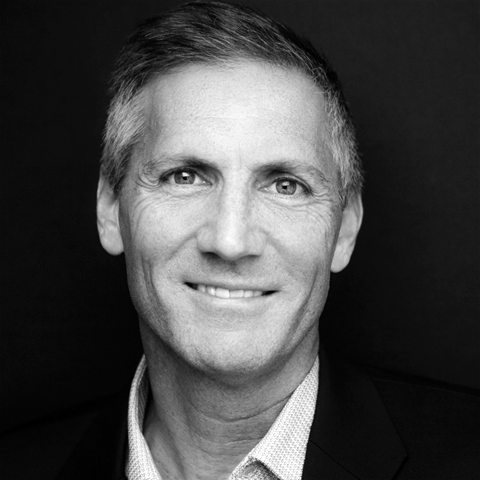
Paul Eisen
Award-winning user experience expert
Paul is an award-winning CX and UX practitioner who creates human-centred, technology-enabled business solutions that help maximize return on investment, build customer loyalty, and generate employee engagement. With many years of experience across multiple industries, technologies, and application areas, Paul collaborates with cross-functional stakeholders to produce solutions that actually work for the end user – that have high end-user adoption, productivity, and satisfaction. Paul also serves as an educator in the human factors program at the University of Toronto.

Dave Cowing
Chief Executive Officer and Co-Founder of NovusNorth
NovusNorth is an outcome-oriented experience consultancy that drives business results by creating compelling experiences for customers and employees in the fintech and financial services industry. Dave has 30 years of experience helping companies ranging from Fortune 500 market leaders to disruptive startups with new ideas.
In this edition of NovusNorth’s thought leadership conversation, Dave Cowing, CEO of NovusNorth, had an opportunity to meet Paul Eisen, award-winning user experience expert.
Paul Eisen has led user experience initiatives across many industries, including financial services, healthcare and consumer packaged goods. Across these varied industries he’s defined and executed human-centered strategies and research; and designed technology-enabled business solutions for customers, employees, vendors and suppliers.
An area of particular interest to Paul is experience practice development, that is, helping organizations large and small put the pieces in place to be able to create great experiences for their customers, employees, and business partners.
Paul also serves as an educator at the University of Toronto, trying to inspire a whole new generation of prospective UX specialists.
NovusNorth is an expert-lead provider of product design, development and delivery services for the FinTech and financial services industry. At NovusNorth, we believe that great digital experiences drive great outcomes.
In this article, we summarize the conversation between Dave Cowing and Paul Eisen.
Read the Transcript
Q: What do we mean by customer experience and user experience?
Paul Eisen
Customer experience is the sum total of all interactions that a customer has with a company across multiple touchpoints involving sales, service and support, while user experience typically refers to the technology components. Now, the bottom line is this. No matter how you may want to position your company’s brand image through your marketing and sales efforts, the experience that you create is your brand.
“The experience you create is your brand.”
– Paul Eisen
“The experience that you create is your brand.”
– Paul Eisen
Q: Why should companies care about creating great digital experiences?
Paul Eisen
I mentioned that the experience that you create is your brand. So, let’s connect brand to business results. This notion of “brand equity” is real. A study by Forbes has shown that for every dollar invested in improving the customer experience, businesses generate around three dollars in return and an 11% increase in revenue. And we also know that companies that invest in design and experience, leaders in the experience space, have greater increases in their valuations than laggards, those who do not invest in design and experience sufficiently. This leadership and this increased share price come through their core operating financials, things like lower cost, customer acquisition, higher customer loyalty, higher employee loyalty, lower customer churn, share of wallet. And then there’s the expense side where there are decreases in development and operating expenses.
Q: There clearly are some compelling hard dollar benefits delivering customer experience. Do you have any examples you can share with us?
Paul Eisen
Sure, that’s a great idea. Why don’t we touch on a couple of real world examples. One of them is a well-known case study where a global technology company with thousands of employees applied human-centered methods to redesign a piece of internal employee-facing software. The results were a productivity benefit of $6.8 million which represents 100 times just in the first year their direct investment in the user experience methods. Now with a large workforce, you can see how the multipliers can be staggering.
I’ll give you another example from my personal experience. A team that I was part of redesigned an ecommerce website in the consumer electronics space using human-centered methods. And we focused on the path to purchase from the homepage through to the product listing and the details pages. And importantly, we started with experience research to understand the information that customers value most in the shopping experience for this particular type of consumer electronics. We then applied best practices in design to render the experience. We restructured both the product listing and the details pages. The result was an immediate and sustained lift in sales of over 50% through the online channel.
“The result was an immediate and sustained lift in sales of over 50%”
– Paul Eisen
“The result was an immediate and sustained lift in sales of over 50%”
– Paul Eisen
Q: Super interesting Paul, a 50% lift is clearly compelling. I love hearing about how companies are achieving business results through the use of human centric methods. Given all this potential value, where should companies start?
Paul Eisen
To do this right, an organization needs to evolve to become truly human-centered. This means that when you create solutions, you need to apply the right methods to discover what end users truly value and then how to deliver that value and only that value. In fact, it’s estimated that billions of dollars are wasted every year globally, in creating features and functions that are not valued by users, and so they’re simply not used.
Now you can and you should start small. So, pick one or two particularly important and high-profile initiatives. For startups this may represent your core and your only offering. While for larger companies this may be a project or a platform that is particularly important to your business growth. Then you need to find the right people inside your company and augment the team is needed with experienced researchers and designers. Execute the methodology faithfully and showcase your results.
“billions of dollars are wasted every year globally, in creating features and functions that are not valued by users.”
– Paul Eisen
“billions of dollars are wasted every year globally, in creating features and functions that are not valued by users.”
– Paul Eisen
Q: You know, I love that idea of starting small but all together this sounds like a lot of change. I’ve got to believe there’s cultural change, operating changes, a mindset shift. How can companies go about doing this?
Paul Eisen
Well, you’ve hit the nail on the head Dave, this is about organizational change. And specifically in the domain of experience there are five capability areas or as I refer to them as pillars that you need to focus on. The first is standards. Now these are best practices in interaction and service design that you adopt for your organization. Now for interaction design there are great pattern libraries out there, such as Google’s Material Design, that you can use as a start.
Alongside this is a human-centered methodology that needs to be codified and integrated into your lifecycle methodologies. Nobody needs a new methodology, but effective integration into your existing methodologies is possible and recommended. Now this is based on the philosophy of Design Thinking and Lean UX, for example, which is a way to integrate experience practices with agile practices.
So, there are standards and methodology and then of course, you need to build the skills and capabilities within the organization in order to continue to develop these and execute against them. We’re talking about people skilled in ethnographic research, experience, strategy, and experience design.
Now across this to ensure that you’re moving in the right direction you need to install a measurement framework. This will allow you to track the successful the success of the initiatives, and of the overall program.
Now to round out this framework you have standards, methodology skills, measurement. And finally, you need to overlay this with a governance model that’s going to work effectively in your culture.
Q: It sounds like a fantastic framework to help companies think about creating capabilities. One of the things that we’ve seen is this notion of stages in developing UX maturity. If I go back to one of your earlier points, you said you recommend that folks start small. With that in mind, how should they start with your framework? And how long should they expect it to take to get to full maturity?
Paul Eisen
You need to walk before you run. In fact, just like other large cultural transformations, such as Agile, you need to evolve this at a pace that your organization can absorb. Now, to do this, you look at those five pillars we just talked about, and they each have to grow in a balanced way. So, for an organization that is highly committed, earlier stage of formation and therefore more nimble, you’re looking at about a year and a half to two years to be able to reach a target level of maturity. While larger, more established organizations, that may have a bit more organizational inertia, we’re expecting typically three to five years to be able to evolve to a full state of maturity.
Q: It sounds like a fantastic framework to help companies think about creating capabilities. One of the things that we’ve seen is this notion of stages in developing UX maturity. If I go back to one of your earlier points, you said you recommend that folks start small. With that in mind, how should they start with your framework? And how long should they expect it to take to get to full maturity?
Paul Eisen
You need to walk before you run. In fact, just like other large cultural transformations, such as Agile, you need to evolve this at a pace that your organization can absorb. Now, to do this, you look at those five pillars we just talked about, and they each have to grow in a balanced way. So, for an organization that is highly committed, earlier stage of formation and therefore more nimble, you’re looking at about a year and a half to two years to be able to reach a target level of maturity. While larger, more established organizations, that may have a bit more organizational inertia, we’re expecting typically three to five years to be able to evolve to a full state of maturity.
Q: Terrific this super insightful. I love the framework. I love the notion of starting small and evolving but I guess there’s a lot of complexities in implementing such a program. What do you see as the top two to three risks to look out for?
Paul Eisen
I’m glad you asked this question about risks, because there are a whole bunch of gotchas. I’ll just mention a few. The first is thinking that you can test your way to a good experience. I used to work with a large financial services organization that executed pretty faithfully, rigorously on the traditional software development lifecycle: requirements, design, development, and user acceptance testing. And towards the end of that cycle, they would reach out to the experience team and say “we understand we need to run this through usability,” which could conjure up this image of a carwash and out would the solution come squeaky clean and full of great experiences at the other end. So just like any mature quality-oriented methodology, you can’t build in quality or experience as an afterthought.
“you can’t build in quality or experience as an afterthought.”
– Paul Eisen
“you can’t build in quality or experience as an afterthought.”
– Paul Eisen
Related to this is another flaw that you often see which is skipping discovery research. So the solution approach and the capabilities you want to build need to be grounded in the human insights that you’ve got gathered from discovery research. If you skip this step you risk creating a superficially good user interface for a product or solution that really doesn’t provide value to the end user.
The last thing I’ll mention is something a bit more technical to design. And it’s really about focusing on the screen. And even when you do a good job understanding what users value, you may end up focusing on incremental functionality being delivered in conjunction with your incremental releases in an agile mode. Now, if you do this without first focusing on establishing a robust experience architecture that is a framework that can grow gracefully over time, then you won’t have the cohesiveness and you won’t have the stability that you need in this platform. So, this is something that should be looked at in a sprint zero type of timeline, alongside the engineering team was focusing on the solution architecture at the same time.
About The Experts

Paul Eisen
Award-winning user experience expert
Paul is an award-winning CX and UX practitioner who creates human-centred, technology-enabled business solutions that help maximize return on investment, build customer loyalty, and generate employee engagement. With many years of experience across multiple industries, technologies, and application areas, Paul collaborates with cross-functional stakeholders to produce solutions that actually work for the end user – that have high end-user adoption, productivity, and satisfaction. Paul also serves as an educator in the human factors program at the University of Toronto.

Dave Cowing
Chief Executive Officer and Co-Founder of NovusNorth
NovusNorth is an outcome-oriented experience consultancy that drives business results by creating compelling experiences for customers and employees in the fintech and financial services industry. Dave has 30 years of experience helping companies ranging from Fortune 500 market leaders to disruptive startups with new ideas.
Let’s Talk!
Trying to find your new north? Get in touch to find out how we can work together to achieve the business outcomes you need.
Our Latest Insights
Founder and Principal of MCE Strategic Consulting Marie Chinnici-Everitt, shares how companies can make a stronger connection between their brand and delivering a superior client experience in today’s competitive landscape in financial services.
By NovusNorth
Client Experience is critical now more than ever. Here are practical strategies for shifting to a client-centric culture and aligning your organization.
By Michelle Palomera
Co-founder and Managing Partner of AuxoAI, Amaresh Tripathy on how enterprises can harness AI copilots to provide enterprise value while improving experience for customers and employees.
By NovusNorth
